The saying has it that there’s not much new under the sun. To which one might add: But a great deal has been forgotten.
Front wheel drive isn’t new, for instance. Nor the independent front suspension. Nor pop-up headlights. Nor the hidden gas filler. These things are in fact almost 100 year old ideas that appeared – and were then largely forgotten for a long time thereafter.
It wasn’t until the ‘60s that pop-up headlights returned. It wasn’t until the ‘80s that front-wheel-drive made a comeback, in America – in the Aries and Reliant K cars that were the basis of Chrysler’s comeback.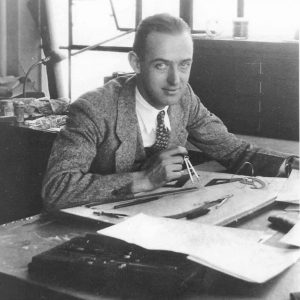
The first American car to come standard with all three (and more) also came standard with a body so uniquely beautiful it is amazing how many have forgotten it.
That car was the 1936 Cord – which only lasted until 1937.
Just barely.
It was conceived as a streamlined, ultra-modern car by its chief designer Gordon Buehrig, who was tapped for the job by the Auburn Automobile Company. Auburn was more than just a deco-era car company. It was a holding company for all kinds of things, including Checker Cab and the precursor to what eventually became American Airlines.
It was owned by the eccentric but very successful Errett Lobban Cord – who named the car designed by Buehrig after himself.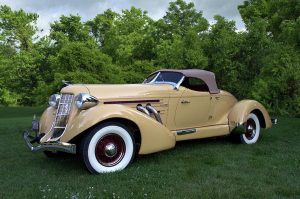
Auburn had already created some very beautiful – and very expensive – cars, including the 1935 Speedster, also designed by Buehrig. This car was also immensely powerful for its time and set many speed records. It was advertised as a “racing car with the comfort of an (enclosed) car. It had a top speed capability of more than 100 MPH at a time when most cars struggled to reach 60. Its supercharged eight-cylinder developed an advertised 150 horsepower.
The Buehrig-designed Speedster’s shape would inspire future designers, including the designer of the 1964 Chevy Corvette, Larry Shinoda – who later went to work for Ford, where he designed Boss Mustangs, among other beautiful things.
But the Speedster was still too expensive a thing for its times. 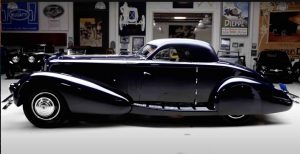
So were Auburns, generally – even though they were meant to be the “affordable” alternative . . . to a Duesenburg.
Duesenbergs – at the apex of the Auburn empire – were the art deco era’s Bugatti Veyrons. A few were offered. Very few were in any position to accept the offer.
High-end cars sold when Wall Street worked – and there were enough people making fortunes sufficient to buy Duesenbergs – and slightly less pricey Auburns.
But after the stock market crashed in 1929, so did sales of these beautiful – expensive – things. Auburn sales crashed by nearly 70 percent by 1932 and Duesenberg sales were essentially nonexistent.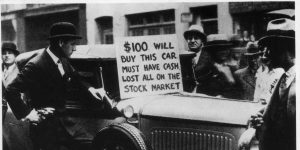
For some reason, this didn’t deter EL Cord from commissioning the building of another such thing at precisely the wrong time for such a thing.
That was the genesis of Cord – the company.
The first car sold under the Cord nameplate was the first American-made front-wheel-drive car. This model didn’t have a name – other than “Cord.” It got a model number, L-29 – the reference being to the year (1929) and the Lycoming eight cylinder engine that developed 129 horsepower, which gave the car a top speed around 80 MPH. It was still too rich for the times, however – with a base price of more than $50,000 in 2022 dollars.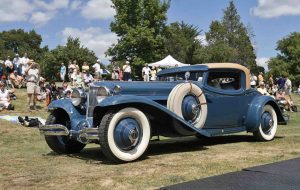
It was cancelled after the 1932 model year.
Back to the drawing board.
What was eventually drawn – by Buehrig – was what became the L-29’s successor, the 1936 Cord 810. It was meant to be a kind of baby Duesenberg, smaller perhaps than the three ton 1934 Walker Coupe made especially for the heir to the Eli Lilly pharmaceuticals fortune but still a very impressive – and technology advanced – car.
It was available in four and two-door/phaeton (convertible) configurations and shared the underlying chassis configuration pioneered by the L-29, including front wheel drive. It was also powered by a new Lycoming flathead V8, which made the Cord the first V8-powered front-wheel-drive car. Even the standard non-supercharged 125 horsepower version of this engine made more than twice the power of the 1934 Citroen Traction Avant’s four cylinder engine.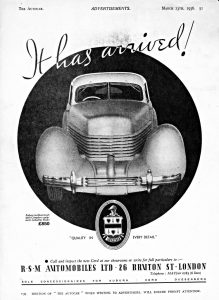
The Citroen was the world’s first front wheel-drive car.
With the optional Schwitzer-Cummins mechanically driven supercharger, the output of the Cord’s V8 soared to 170-plus.
The V8 was mounted so that the bulk of the engine’s weight was behind the front axle line, for better weight distribution. As in the Traction Avant, the Cord’s front wheel drive orientation eliminated the need for a separate drive axle mounted in the rear of the chassis – and that eliminated the need for a longitudinal driveshaft connecting it to the transmission up front.
The Cord’s transmission was a kind of semi-automatic unit that had a mechanical clutch – but not a mechanical shifter, per se. There was a toggle switch pre-selector mounted on the right side of the steering column, which the driver used to pick the gear he wanted to be in next. As he released the clutch, electro-vacuum-actuators engaged the gear selected.
It was called the Electric Hand.
That wasn’t all that was unusual about the Cord’s transmission, which featured something else that isn’t new – but was forgotten – for many years:
All new cars have such transmissions now, chiefly for fuel economy reasons. Many have multiple overdrive gears. Each overdrive gear reducing engine speed at a given road speed. Multiple overdrive gears allow a gradual step-up (mechanically, it’s actually a step down numerically) that incrementally cut back engine revs while maintaining sufficient leverage to maintain road speed. In the highest overdrive gear, engine speed can be reduced to not much faster than idle speed – even though the car is traveling at highway speeds.
It also enables higher top speeds.
Cars without overdrive have top speeds limited by their gearing. In particular, their final gearing. That being a function of the gear ratios in the transmission as well as the final drive gear in the axle.
Before there were overdrives, it was necessary to compromise. You could choose a high top speed and easier high speed cruising – at the cost of sluggish initial acceleration. Or you could choose jack-rabbit acceleration – and a lower/mechanically limited top speed.
If a car had a low axle ratio (e.g., 3.73:1) it had more mechanical leverage, which helped it to accelerate more quickly. But if it didn’t have an overdrive gear in the transmission, it was slowed down – on top – by the mechanical limitation of its gearing. The engine might have the horsepower to get the car to 130 MPH. But if the gearing in the transmission’s top gear was only 1:1 while the gearing in the axle was 3.73:1 the car’s engine would be screaming near redline at closer to 115 MPH (or less, depending on the gearing).
Such gearing also made the car unpleasant to drive at speeds well below top speed, because of all the revving.
On the other hand, if you had a car with a high (numerically, lower) axle ratio – e.g., a 2.4:1 ratio – you had a good “highway” car; one that was more comfortable to drive at high speed and capable of higher speeds.
But at the cost of being slow, down low.
Overdrive solves both problems. You can have a car with good acceleration in the lower gears and a car that isn’t over-revvy at higher speeds.
But the Electric Hand proved to be part of the Cord’s undoing, because the vacuum-apparatus sometimes didn’t change gears properly – as when there was no vacuum to power the mechanism. If you left the transmission in gear with the engine off you might not be able to get it out of gear.
Such bugs are common with envelope-pushing technology, as Preston Tucker discovered a couple of decades later. But daring to be different is what makes a car . . . memorable.
The Cord’s front-wheel-drive layout also enabled something else that is now common: The absence of a driveline hump intruding into – and bisecting – the car’s interior space.
Because there was no driveshaft connecting the back of the transmission to the axle, in the rear of the car, the Cord’s floor was flat. This increased footwell space within the car, which helped to make the small interior feel less so because there was no hump in between the seats and no lump protruding into the passenger compartment from the firewall, as in rear drive cars that have to shape their front floorpans to accommodate the shape of the transmission which lies underneath them.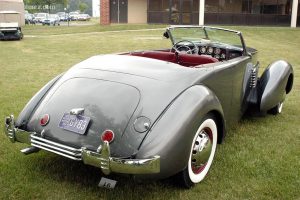
This had more than just a space-efficiency benefit. It had a very important aesthetic benefit. Because there was no need to press a driveshaft hump into the floorpans – or raise the car up, so that the driveshaft had adequate clearance – Buehrig and his team of stylists – which included a young Alex Tremulis, who a few decades later helped Preston Tucker design the ’48 Torpedo – lay out a streamlined, low to the ground body that dispensed with the need for running boards to enable the driver and passengers to climb aboard.
Just open the doors and step in.
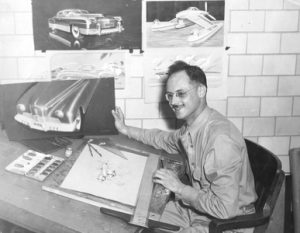
In between were floating pontoon fenders curved to let the airstream flow over them smoothly. Each front fender housed an aircraft-sourced headlight (Stinson – which made these, was part of EL Cord’s empire) hidden under a mechanically opening and closing flush-mounted door.
To open these, the driver rotated a knob on the left side of the dashboard. This was a much more reliable way to open and close hidden headlights than the vacuum-actuated systems used decades later – when hidden headlights were remembered.
But the thing that set the Cord apart from any other car of its time – or ours – was what sat in between the pontoon fenders. This was the famous “coffin nose” under which the V8 lurked. There was no traditional grille, the usual/visual point of separation between the hood and the front end of the car. Instead, an array of of stacked slats wrapped around the “coffin,” front to back.
The effect was one of imposing seamlessness. Glancing in the rearview to catch sight of a Cord bearing down on you was probably plenty to prompt one to move over.
There was also function along with this form.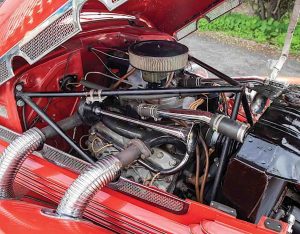
The Cord’s hood did not open to the side – like a coffin. Like the hoods of most contemporaneous cars, which did – making it awkward to get at one side of the engine. The Cord’s hood was rear-hinged – and opened up. This made it much easier to get at – and to see – the Lycoming V8 when it was raised.
Those Duesenberg-like pipes coming out of the sides worked, too.
They carried away the spent exhaust gasses, in style. There was more of the same, inside. The driver sat before a sheet of engine-turned aluminum behind which was housed a full array of instruments – including one of the first tachometers ever installed in a street car.
In addition to the hidden cap the door hinges were also hidden, further streamlining the appearance of this beautiful – but flawed – car.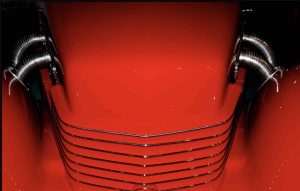
It was prone to overheating – in part because of the occluded cooling system, a textbook case of function following form. The Cord’s coffin nose and hidden headlights created a very aerodynamic and attractive profile but also restricted airflow – over the radiator. The optional supercharger made matters worse by making more heat, which was even harder to dissipate.
Another problem was leaks – of everything. That made a mess as well as potential mechanical problems, two more things that people who ponied up Baby Duesenberg money were not willing to put up with.
To Cord’s credit, the car was nonetheless a phenomenal achievement – both artistically and functionally – given the pressure to get it built fast and the pressure imposed by cost-cutting measures imposed by the belt-tightening of the Depression. Some of these cost-cutting measures ended up working out to the car’s benefit, such as the drum brake overheating issue being fixed by drilling holes in the wheel covers, to cool the brakes.
Some few even noticed – such as the use of the same doors for the front and rear doors of the sedan.
But the car was just too reliant on its looks to live. These were not sufficient – at the time – to cover up its flaws, which included a base price of just under $2,000 for the entry-level 1936 sedan – equivalent to more than $40,000 today. A phaeton with the supercharged V8 would have run you closer to $3,000 back then – or about $45,000 in today’s coin.
Plus, people out of work were prone to throw rocks at such cars – when many people couldn’t afford to eat, much less drive.
Today, of course, $45k is a nice down payment on a Cord – if you can find one. Fewer than 3,000 were made over the car’s very brief two-year production run, which actually lasted only about one year – as most of the “1937” models were in fact left over 1936 cars that were re-numbered and sold as “1937” models.
When Cord closed shop, it was also the end for Auburn and Duesenberg, too.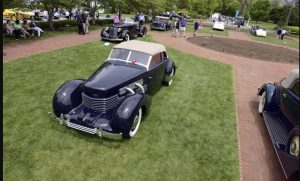
Part of the reason for this was due to the Depression. But part was also due to Cord – the man – getting caught up in a sketchy stock-gaming scheme intended to conjure desperately needed funds to keep his car business alive. It presaged what another great innovator – John Z. De Lorean – would try almost half a century later to save his faltering car company.
He apparently forgot what happened to EL Cord – but learned all about it.
EL Cord eventually sold all of his shares in Auburn/Cord and left the car business for good. He ended up making a fortune not making cars, in California real estate. Few recall his name today.
But the beautiful thing he gave us is something that can never be forgotten.
. . .
Nutz & Boltz:
-
- The Cord’s two model years are denoted by 810 (for 1936) and 812 (for 1937). But most of these were built the same calendar year (1936). This was similar to the practice of Duesenberg. All of them were actually built in 1929 but were considered whatever year they were eventually sold.
- Only the supercharged models came with the pipes from the factory – but many owners of standar models added the distinctive pipes to complete the look.
- There were four models within these model years: The standard sedan, the next-up Beverly; then the Sportsman and then the Phaeton. These all rode on a common 125-inch wheelbase. Also available was a longer 132-inch wheelbase iteration, the Custom Beverly and Westchester.
- Lycoming continues to build aircraft engines, most famously its line of air-cooled/horizontally-opposed fours, sixes – and eights. In the late 1920, EL Cord bought Lycoming and it became part of Auburn and provided engines for Cord automobiles.
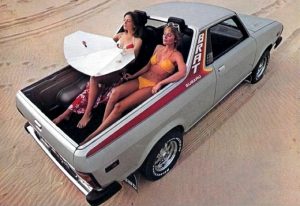
- Buehrig design team member Alex Tremulis went on to work for Subaru, where he designed the BRAT pick-up of the early-mid 1980s. That model was known for its bed-mounted, rear-facing jumpeats and available aircraft-style spotlights mounted in the roof.
- Another Cord first was variable speed windshield wipers that were not vacuum-operated and thus kept on wiping the windshield even when engine vacuum was low – as when the driver opened the engine’s throttle by standing on the accelerator pedal.
- The public wanted Cords; there were overflow crowds at the 1935 New York Auto Show, where the prototypes were on display. The problem was Cord couldn’t build the cars to fill the orders due to problems with the vacuum-actuated transmission, among other things. The hoped-for 1,000 cars a month ended up being just shy of 3,000 cars in two years. Reportedly – almost miraculously – about two-thirds of these cars have survived.
- It’s probably not coincidental that the next American front-wheel-drive cars – the ’66 Oldsmobile Toronado and the ’67 Cadillac Eldorado – also featured hidden headlights and echoe’d the imposing, streamlined shapes of the Cord 810/812.
Excerpted from the forthcoming (soon!) book, Doomed.
. . . .
Got a question about cars, Libertarian politics – or anything else? Click on the “ask Eric” link and send ’em in! Or email me at [email protected] if the @!** “ask Eric” button doesn’t work!
If you like what you’ve found here please consider supporting EPautos.
We depend on you to keep the wheels turning!
Our donate button is here.
If you prefer not to use PayPal, our mailing address is:
EPautos
721 Hummingbird Lane SE
Copper Hill, VA 24079
PS: Get an EPautos magnet or sticker or coaster in return for a $20 or more one-time donation or a $10 or more monthly recurring donation. (Please be sure to tell us you want a magnet or sticker or coaster – and also, provide an address, so we know where to mail the thing!)
My eBook about car buying (new and used) is also available for your favorite price – free! Click here. If that fails, email me at [email protected] and I will send you a copy directly!


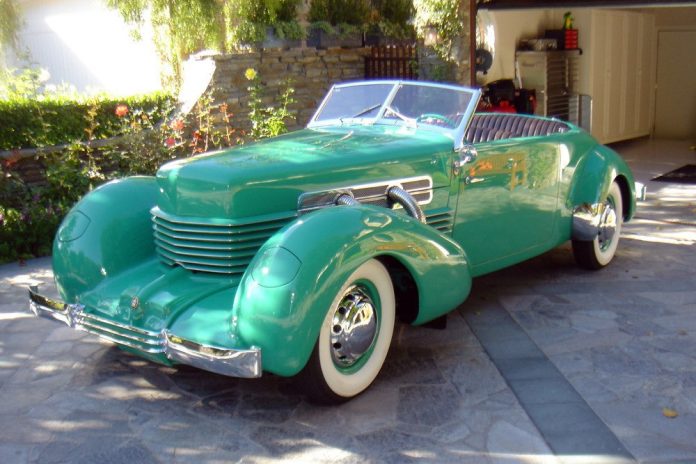

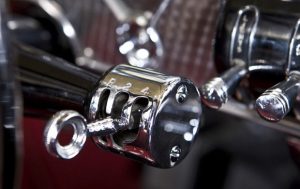









Beautiful car and very well written review.
Any pre-2000s car stands out on the roads among the sea of grey and white crossovers and butt-in-the-air sedans.
These beauties are guaranteed to turn heads and steal hearts.
Very kind of you to say so, Escher – much obliged!
Eric, loved this article. Gordon Buehrig wrote a book, Rolling Sculpture, in the seventies about his life and work. It’s probably not available anymore so your article is welcome.
My pleasure, Rik – and thanks for the kind words!
I enjoyed writing it, too. It’s nice to get back to something good, for a change!
There’s a nice example at the Henry Ford museum in Dearborn MI. IIRC it was in a line of a bunch of prewar automobiles, but really stood out. You couldn’t not notice it, especially next to all the squared off boxes of the day. Even their Duesenberg is upstaged by the Cord.
I’d like to get a print of that title picture and hang it on my wall! What a car! What a color! That’s gotta be one of the most beauty-full cars I’ve ever seen!
Amen, Nunz!
I got to see one in person many years ago; the pictures don’t do it justice….
Lucky you, Eric!
I’ve long been aware of the Cord name…but never really ‘knew’ about them…what they were. I think these have instantly become my most favoritist cars!
And soon I have to go out on the road and will be forced to see these disgusting plasticky all-look-the-same modern excuses for cars….. 🙁 and the bleakness of our present world will be rubbed in. But seeing cars like these Cords reminds me of when there was still actual life…and it was rich…..
Many many years ago I saw the 810 or 812 Cord that is in the Henry Ford Museum. Or at least was at that time. If I had Jay Leno car money….
Hi Brent,
Yup!
Years ago, I got to sit in a non-supercharged Beverly sedan. I have always wanted to test drive a supercharged Phaeton. Of course, I also want to fly a Cirrus Vision Jet…
Agree with others. Sad that there is not more variety and beauty left in the industry. Government involvement destroyed it.
..sigh
I’m sorry I missed that. Spent a long time in Vegas and only went to the Imperial palace car museum twice. I vaguely remember seeing a Duesenberg.
Its taken getting older to have a greater appreciation for the finer things in life. Kudos on the Unicorn sighting, a rare treat that.
They were probably sold after Mr. Engelstad’s passing.
https://insomniacgarage.blogspot.com/2013/04/lost-vegas-imperial-palace-duesenberg.html
I don’t know of any museum that can match the number of Duesenbergs that place had.
Interesting! I thought that particular Cord was pricier than that.
My God.
Look at those not-fat, un-tattooed girls in the Subaru ad.
Did such creatures ever really exist?
I did see a unicorn today. This girl was like a blonde Natalie Wood – petite and doll-faced. No tattoos or gross piercings to be seen.
I hate you for pointing out that 1937 is “almost 100 years” ago, not 60-something like I thought it was.
I love the look of this car, and to me, the front end has whispers of tractor. Seems like even if the hood hinges in the back, you still have to lean over those enormous swooping fenders or the set back in front to do the mechanicals.
Anyway, thanks for another peek into a unique, if short-lived auto.
This was a thoroughly enjoyable and very informative article, Eric!
Just before leaving NY I saw Billy Joel driving a car that looked a lot like one of these. (Well, actually my mother saw him, and when she said “Look at that car he’s driving” I looked. What a gorgeous car to see in-person. A block from where I lived at the time, no less, as there was a guy near me who dealt in such vintage cars, and seeing as how Joel was half a block from that guy’s house when we saw him, I assume that was his destination).
Just the thought and imagery of what these cars stand for, and the time they represent! When people of means sought-out good things which were actually good and functional and durable, and not mere status symbols meant to impress cretins! When manufacturers strove to satify customers rather than preach socialistic garbage to them while seeking only to please Uncle……
What we have lost! That lost world has not been dead for very long….many of us here grew up still seeing the extant remnants of it…… I mourn for the young’uns who don’t know what has gone extinct, and whose Marxist teachers tell them that those wonderful days were times of brutality and ‘racism’…
Definitely gorgeous cars and nice to have a topic that doesn’t make me want to do something involving our “public servants” that I’d wind up regretting.
The Cord has kind of a strange and short second life as the 1940 Huppmobile Skylark and Graham Hollywood. In short Hupp Motors was in dire straights and bought the dies for the Cord body, had Graham build the bodies, and fitted them to the existing Huppmobile rear-drive chassis and drivetrain. Graham had their own version. Unfortunately the Cord body was difficult and expensive to manufacture and few were built, and both companies collapsed in short order.
http://www.classiccarweekly.net/2019/05/24/hupmobile-skylark/
(Posting this separately since multiple links tend to be blocked.)
Another resurrection was in the 1960s as the scaled down Cord 8/10, powered by a Corvair engine and transmission fitted to the front to provide front wheel drive.
https://www.hemmings.com/stories/2014/04/21/celebration-to-mark-50th-anniversary-of-glenn-prays-corvair-powered-cord-810
what i miss most about old cars was the variety
more competition created more innovation and ideas
Oh man, those are pretty cars!
I don’t think I’ve ever seen or heard of them before now, even at car shows.
To think of what might/could have been…
‘Reportedly – almost miraculously – about two-thirds of these cars have survived.’ — eric
Amazingly, Tom Mix’s cream-yellow supercharged Cord 812 survived, despite Mix himself perishing in an accident in Oct 1940, crashing into a wash in Arizona after missing warning signs that a bridge was out.
https://www.bonhams.com/auctions/17327/lot/224/
Apparently, people recognized immediately after production ceased that Cords were rare, valuable, and irreplaceable.
Cord’s fate was sealed by the second recession of the 1930s, from May 1937 to June 1938. Short but harsh, it chopped auto production in half, from 932,000 in 1937 to 465,000 in 1938.
It took until 1941 for production to recover to a new high above 1 million. Then Frank Roosevelt’s requisitioning of factories for production of war materiel stopped ALL auto production in early 1942.
Neat history. Thanks for sharing.
Thanks Eric, this was a great read. I knew some about the Cord from Jay Leno. I did not know about Alex Tremulis and the Subaru Brat. Nice to read something that doesn’t make me want to grab the .357 magnum and go postal.
Thanks, Zane – I felt the same, writing it!
Hey Eric, et al,
If you are ever in Sandwich, MA have a look at the J.K. Lilly Car museum. It’s been a while and the venue used to be part of the Lilly Plantation but that name had to go….in any case, when I was there in 2018 they had Gary Cooper’s 1930 Duesenberg Model J Derham Tourster, an Auburn Boattail (no longer there apparantly) and a 1936 Cord 810 Westchester. All of the cars there were made in America including a 1922 Rolls Royce Silver Ghost. The Duesenberg had a 265 HP engine….ENGINE: Straight 8, overhead valve configuration actuated by dual overhead camshafts, 4 valves per cylinder, 427 cu. in./6.9 l. I’m sure given the location that a visit today would require a face burka and proof of self-abuse from Pfizer. Oh well….
Defiantly a car I’d like to drive before I die. Love the pipes coming out the side. Another cool place to visit is the car museum in Memphis, down the street from Sun studios. We visited last winter and Sun studios was closed due to some faggoty flu. The car museum was open and we walked around without masks. Some really cool cars in there.
Thanks for the article Eric. It was a nice respite from the doom and gloom.
The late Ralph Engelstad had an amazing Duesenberg collection at his Imperial Palace back in the day. I was a little kid when I walked through it – wish it were still around.